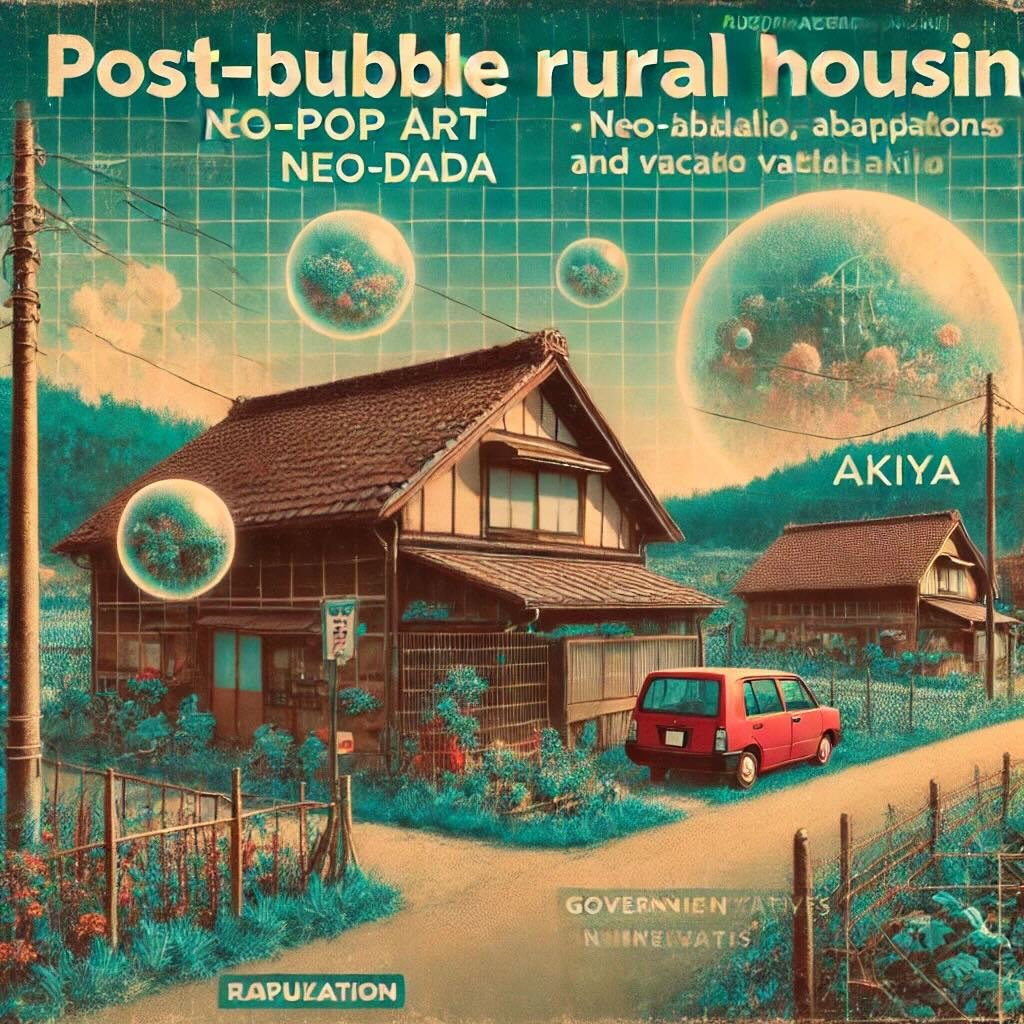In the 1980s, Japan was riding an economic wave that seemed unstoppable. The country’s rapid industrialization and urbanization fueled a massive boom in real estate, particularly in major cities like Tokyo. Property values skyrocketed as everyone—from large corporations to individual investors—wanted a piece of the action. The idea was simple: buy now, watch the value soar, and sell at a profit. It was a golden era, or so it seemed.
But by the early 1990s, the bubble burst. What followed was a decade of economic stagnation, often referred to as Japan’s “Lost Decade.” Property values plummeted, leaving a trail of financial wreckage in their wake. The burst didn’t just affect urban centers; it rippled out, leaving lasting impacts on both urban and rural housing markets across the country.
source: Explained With Dom
Overview of Japan’s Housing Bubble
This article dives into the aftermath of that burst, specifically looking at how Japan’s urban and rural housing dynamics have shifted in the decades since. While much of the attention often focuses on urban areas like Tokyo, where recovery has been slow and complex, the story is different—and in some ways more dramatic—in rural areas. Understanding these shifts is key not only to grasping the economic and social changes Japan has undergone but also to anticipating future trends in the housing market.

Relevance to Current Trends
Why should we care about these shifts today? Japan’s demographic landscape is changing rapidly, with an aging population and shrinking workforce, which presents new challenges and opportunities in both urban and rural housing markets. Moreover, as the country navigates these changes, the lessons learned from the post-bubble era are more relevant than ever. Whether you’re a potential homebuyer, a real estate investor, or just someone interested in Japan’s socio-economic trends, understanding these dynamics can offer valuable insights into where the market is heading next.

The Urban Housing Market Post-Bubble
Decline in Urban Property Values
Immediate Aftermath
When Japan’s economic bubble burst in the early 1990s, it wasn’t just a blip on the radar—it was a seismic event. Urban property values, which had once soared to unimaginable heights, plummeted almost overnight. In Tokyo, the epicenter of the boom, prices that had seemed untouchable suddenly crashed, leaving investors and homeowners alike grappling with severe losses. The immediate aftermath was a period of shock and adjustment, as the market reeled from the dramatic reversal of fortune. The once vibrant real estate sector found itself in disarray, with properties losing a significant portion of their value, almost as if the floor had fallen out from beneath them.
Long-Term Impact
But the decline didn’t just stop there—it lingered. For years, urban property values remained stagnant, a stark contrast to the explosive growth of the 1980s. This stagnation wasn’t merely an economic issue; it became a symbol of Japan’s broader struggle to regain its footing after the bubble. Urban housing markets, particularly in large cities like Tokyo and Osaka, were stuck in a rut. Developers became cautious, and the once feverish pace of construction slowed to a crawl. This long-term stagnation had a profound impact on the urban landscape, affecting everything from homeownership rates to city planning strategies.
Changes in Urban Living Preferences
Population Shifts
As Japan’s economy faltered, so too did its population dynamics. The country’s aging population, combined with low birth rates, began to reshape urban living preferences. Younger generations, facing uncertain economic prospects, gravitated towards more affordable, compact living spaces. Large, sprawling homes were no longer in demand; instead, the focus shifted to smaller apartments that offered convenience and proximity to work and amenities. This shift was particularly pronounced in Tokyo, where the cost of living remained high despite the overall stagnation in property values.
Urban areas began to see a new kind of resident—one who prioritized efficiency and affordability over space. This change in preferences not only reflected economic realities but also marked a cultural shift in how people viewed homeownership and city living. The traditional dream of a large, single-family home became less attainable and, for many, less desirable.
Rise of Compact Living
In response to these changes, the concept of compact living took root. Urban centers, especially Tokyo, saw a rise in the development of smaller, more efficient living spaces. Micro-apartments, which maximize utility in minimal square footage, became increasingly popular. These spaces, often located in central areas, offered a solution to the challenges of urban living in a post-bubble Japan. For many, these compact homes provided the perfect balance of affordability and convenience.
The rise of compact living also sparked innovation in design and architecture. Developers began to experiment with layouts that made the most of limited space, incorporating features like built-in storage and multi-functional rooms. This trend not only reflected the changing needs of the population but also represented a shift towards more sustainable, resource-efficient living in densely populated urban environments.
Real Estate and Development Trends
Redevelopment of Urban Areas
As the dust settled from the bubble’s burst, attention turned to revitalizing Japan’s urban centers. Redevelopment became a key strategy for breathing new life into aging cityscapes. Older buildings, many of which had been constructed during the boom years, were either renovated or replaced with modern, more functional structures. Tokyo, in particular, saw a wave of redevelopment projects aimed at transforming outdated neighborhoods into vibrant, mixed-use districts.
This focus on redevelopment wasn’t just about aesthetics; it was about adapting to the new economic and social realities of post-bubble Japan. City planners and developers worked to create environments that could support a diverse range of activities—from residential and commercial to recreational and cultural. The goal was to make urban areas more livable, attractive, and economically viable in the long term.
Mixed-Use Developments
One of the most significant trends to emerge from this period of redevelopment was the rise of mixed-use developments. These projects, which combine residential, commercial, and recreational spaces, became increasingly common in Japan’s urban centers. The idea was to create self-sustaining communities where people could live, work, and play without the need for long commutes or extensive travel.
Mixed-use developments not only made cities more functional but also helped to address some of the challenges of urban living, such as the need for greater convenience and access to amenities. In areas like Tokyo, these developments became a symbol of the city’s ability to adapt and innovate in the face of economic adversity. By integrating different aspects of daily life into a single, cohesive environment, mixed-use developments offered a glimpse of what the future of urban living in Japan might look like—a future shaped by the lessons of the past, but firmly focused on the needs of the present.

The Rural Housing Market Post-Bubble
Rural Depopulation and Housing Decline
Impact of Urbanization
While Japan’s urban centers were grappling with the aftermath of the bubble, rural areas were facing a different set of challenges. Urbanization, a trend that had been accelerating even before the bubble burst, continued to draw people away from rural regions. The allure of city life—better job opportunities, access to amenities, and a more vibrant social scene—proved irresistible, particularly to younger generations. As a result, rural areas began to empty out, with small towns and villages losing residents at an alarming rate.
This depopulation had a profound impact on the rural housing market. With fewer people to maintain and inhabit them, homes in these areas began to fall into disrepair. Properties that had once been family homes were abandoned, left to the elements as their owners moved to the city. This trend created a stark contrast between the bustling, crowded urban centers and the increasingly deserted rural landscapes. The shift was not just a physical one but also a cultural change, as the traditional rural way of life slowly eroded under the pressures of modernity and economic necessity.
Vacant Homes (Akiya Problem)
One of the most visible consequences of this rural depopulation is the rise of vacant homes, or “Akiya” as they are known in Japan. These abandoned properties have become a significant issue in many rural areas, with entire neighborhoods sometimes left deserted. The Akiya problem is more than just an eyesore; it represents a broader decline in the viability of rural living. These empty homes are often in poor condition, making them unattractive to potential buyers or renters. The cost of demolition or renovation can be prohibitive, leaving these properties to decay further.
The implications of the Akiya problem are far-reaching. As more homes are abandoned, local governments face a shrinking tax base, which in turn limits their ability to provide services and maintain infrastructure. The cycle of decline can be hard to break, with fewer resources leading to further depopulation and more vacant homes. It’s a complex challenge that has spurred both concern and action at various levels of government.
Government Initiatives and Policies
Incentives for Rural Living
In response to the growing challenges in rural areas, the Japanese government has launched several initiatives aimed at reversing the trend of depopulation. Incentives for rural living have become a key strategy in these efforts. These incentives range from financial subsidies for families willing to relocate to rural areas to tax breaks for businesses that set up operations outside of major cities. The goal is to make rural living more attractive by offsetting some of the economic disadvantages that have driven people to urban centers.
These incentives also target specific demographics, such as young families and retirees, who might be more open to the idea of rural living. The government has also promoted the idea of telecommuting, encouraging companies to allow employees to work remotely from rural locations. This approach not only helps to alleviate the pressure on urban housing markets but also breathes new life into struggling rural communities.
Revitalization Programs
Beyond individual incentives, the government has also implemented broader revitalization programs aimed at rejuvenating rural areas. These programs often focus on repurposing vacant homes and other underutilized properties. For example, some initiatives provide grants or low-interest loans to individuals or businesses willing to renovate and occupy Akiya. Other programs focus on creating new economic opportunities in rural areas, such as promoting local tourism, agriculture, or artisanal industries.
One notable example is the “Akiya Bank” initiative, where local governments compile databases of vacant homes and match them with potential buyers or renters. These programs are designed to make it easier for people to find and purchase rural properties, often at very low prices. By connecting people with available properties and offering financial support for renovations, the government hopes to reverse the decline in rural areas and restore vitality to these communities.
While the success of these efforts has been mixed, they represent an important acknowledgment of the need to address the disparities between urban and rural Japan. The future of Japan’s rural areas may well depend on the continued evolution and expansion of these revitalization efforts.

Comparing Urban and Rural Housing Dynamics
Divergence in Property Values
Urban vs. Rural Price Trends
Since the burst of Japan’s housing bubble, the trajectory of property values in urban and rural areas has taken decidedly different paths. In urban centers like Tokyo and Osaka, property values, after an initial sharp decline, have stabilized and, in some cases, even rebounded. The demand for housing in these bustling cities remains high, driven by factors such as employment opportunities, amenities, and the continued influx of people seeking the benefits of city life. As a result, urban property markets have maintained a degree of resilience, with prices reflecting the ongoing demand.
In contrast, rural areas have seen a much different trend. Property values in these regions have often continued to decline, or at best, remained stagnant. The lack of demand, driven by ongoing depopulation and the exodus of younger generations to urban centers, has left many rural properties undervalued. This divergence in property trends highlights a growing disparity in Japan’s real estate market, where the gap between urban and rural property values continues to widen.
Investment Potential
These contrasting trends have significant implications for real estate investment. Urban areas, with their stable or rising property values, present attractive opportunities for investors looking for growth and stability. The strong demand and limited supply in cities like Tokyo ensure that urban real estate remains a relatively safe bet, particularly in prime locations. However, this attractiveness comes with a higher entry cost, making urban investments potentially less accessible for small-scale or first-time investors.
On the other hand, rural properties, with their lower prices, offer a different kind of investment potential. For those willing to take on the risks associated with rural depopulation and the Akiya problem, these properties can be acquired at a fraction of urban prices. Some investors see value in these rural areas, particularly as the government introduces incentives and programs to revitalize these regions. However, the potential for appreciation remains uncertain, making rural real estate a more speculative investment.
Demographic Influences
Aging Population
Japan’s aging population is one of the most significant demographic forces shaping both urban and rural housing markets. In urban areas, the aging population has led to a demand for more accessible housing options, including smaller, centrally located apartments that cater to elderly residents. This shift has influenced urban development trends, with a focus on creating age-friendly environments that offer convenience and access to healthcare and social services.
In rural areas, the impact of an aging population is even more pronounced. As younger residents leave for urban centers, those who remain in rural communities are predominantly older, leading to a shrinking and aging population base. This demographic trend has exacerbated the Akiya problem, as older homeowners pass away or move into care facilities, leaving their properties vacant. The aging rural population also poses challenges for maintaining local economies and services, further contributing to the decline in property values.
Young Families and Rural Living
Despite the challenges, there is a growing interest among some young families in relocating to rural areas. Attracted by lower living costs, government incentives, and a slower pace of life, these families see rural living as a viable alternative to the high costs and stresses of urban life. The government’s efforts to promote rural revitalization, including financial incentives for relocating and renovating Akiya properties, have also played a role in this trend.
For these families, the appeal of rural living goes beyond just affordability. Rural areas offer more space, a closer connection to nature, and a sense of community that is often harder to find in crowded urban environments. While the number of young families making this move is still relatively small, it represents a potential shift in Japan’s demographic trends, with implications for both rural revitalization and urban housing demand.
Infrastructure and Accessibility
Urban Infrastructure Development
Urban areas in Japan have continued to see significant investment in infrastructure to support their dense populations. From advanced public transportation systems to modern utilities and high-tech amenities, cities like Tokyo and Osaka are well-equipped to handle large numbers of residents and visitors. This ongoing development not only makes urban living more convenient but also helps to sustain property values by ensuring that urban areas remain desirable places to live and work.
Moreover, the focus on smart city initiatives and sustainable development has further enhanced the appeal of urban living. Investments in green spaces, renewable energy, and digital infrastructure are transforming cities into more livable and environmentally friendly environments. These developments attract both residents and businesses, reinforcing the strength of the urban property market.
Rural Accessibility Challenges
In contrast, rural areas face significant challenges when it comes to infrastructure and accessibility. Depopulation has led to a reduction in services and infrastructure maintenance in many rural regions, making these areas less accessible and less attractive to potential residents and investors. Roads, public transportation, and utilities in rural areas are often in disrepair or have been scaled back due to the declining population, creating a vicious cycle where poor infrastructure further discourages settlement and investment.
Efforts to improve rural infrastructure have been made, but they often struggle to keep pace with the needs of these declining communities. The challenge is not just about building or maintaining infrastructure but also about ensuring that it meets the needs of a smaller, older population. This includes access to healthcare, internet connectivity, and transportation—services that are essential for making rural living viable but are often lacking in these areas.

Future Outlook for Japan’s Housing Market
Predictions for Urban Housing
Continued Urbanization
Urbanization in Japan shows no signs of slowing down. As the country continues to grapple with an aging population and economic centralization, cities like Tokyo and Osaka are likely to see ongoing growth and development. The allure of job opportunities, education, and lifestyle amenities keeps drawing people into urban centers, perpetuating the demand for housing. But unlike the expansive growth of the past, the future of urban living in Japan is set to focus more on redevelopment and high-density living.
With space at a premium, redevelopment projects will aim to maximize the utility of available land, transforming old, underutilized areas into vibrant, multi-use communities. Expect to see more high-rise apartments, compact living solutions, and smart city initiatives that cater to the needs of a densely populated urban environment. The future of urban housing in Japan is likely to be marked by efficiency, innovation, and a continued push towards creating livable, sustainable spaces that can accommodate a growing number of residents.
Potential for Gentrification
However, with redevelopment comes the potential for gentrification. As older, less affluent neighborhoods are revitalized, property values can skyrocket, pricing out long-term residents and altering the social fabric of these areas. While gentrification can bring economic benefits and improve local infrastructure, it also raises concerns about housing affordability and social equity.
In Japan, this could manifest in urban centers where redevelopment efforts are concentrated. As new developments cater to wealthier residents and businesses, lower-income families may find themselves pushed to the fringes of the city or forced to relocate altogether. This dynamic poses a challenge for policymakers who must balance the benefits of urban revitalization with the need to maintain affordable housing options for all residents.
Revival of Rural Housing?
Sustainable Rural Living
While urbanization continues, there’s growing interest in the revival of rural housing, fueled by several emerging trends. Remote work, lifestyle changes, and government policies aimed at rural revitalization are all contributing to a newfound appeal for rural living. With more people able to work from anywhere, the lower cost of living and the appeal of a quieter, more spacious environment are drawing some away from the hustle and bustle of the city.
Government initiatives, such as subsidies for moving to rural areas and financial support for renovating vacant homes (Akiya), are also playing a role. These efforts aim to breathe new life into Japan’s rural regions, encouraging young families, retirees, and even digital nomads to consider the benefits of rural living. If these trends continue, we could see a slow but steady revival of rural communities, with a more sustainable approach to living that leverages the advantages of technology and government support.
Challenges to Overcome
However, the path to a rural revival is not without its challenges. Infrastructure and access to services remain significant hurdles. Many rural areas suffer from poor transportation links, inadequate healthcare, and limited access to education and other essential services. Without addressing these issues, the appeal of rural living may remain limited, even with government incentives.
Moreover, the social and economic isolation of rural areas can be a deterrent, particularly for younger generations who are accustomed to the conveniences of city life. To truly make rural living viable, there needs to be a concerted effort to improve infrastructure, create job opportunities, and ensure that these communities can offer a quality of life comparable to that of urban areas. Overcoming these challenges will be key to the success of any rural revitalization efforts in Japan.
Implications for Real Estate Investors
Investment Opportunities
For real estate investors, Japan’s shifting housing dynamics present both opportunities and risks. Urban redevelopment projects, particularly in prime locations, offer potential for significant returns as demand for housing in these areas remains strong. Investors looking to capitalize on the continued urbanization trend should focus on areas targeted for redevelopment, where property values are likely to appreciate.
On the other hand, rural properties, though riskier, may offer unique opportunities for those willing to take a long-term view. With government support and the potential for lifestyle-driven migration, investing in rural properties could yield returns as these areas gradually revive. Investors could also explore opportunities in tourism-related properties or eco-friendly developments, which align with the growing interest in sustainable living.
Risk Factors
However, investing in Japan’s real estate market is not without its risks. In urban areas, the potential for gentrification and the resulting social pushback could impact property values and rental yields. Additionally, the high cost of entry in cities like Tokyo may limit the accessibility of urban investments for some investors.
Rural investments come with their own set of challenges. The uncertainty of a rural revival, coupled with ongoing depopulation and infrastructure issues, makes these investments inherently risky. Investors must carefully assess the viability of rural properties, considering factors such as location, accessibility, and the likelihood of future development or government support.
12-Question FAQ: Shift in Japan’s Urban vs. Rural Housing Dynamics Post-Bubble
1) What changed in Japan’s housing market after the 1990s bubble burst?
Urban land prices collapsed from extreme highs and then stagnated; rural values generally drifted lower amid depopulation, widening the urban–rural gap.
2) How did urban prices and activity evolve over time?
After a sharp drop and long malaise, select metros (Tokyo/Yokohama/Osaka cores) stabilized and revived via redevelopment, transit-oriented projects, and infill.
3) Why did compact living rise in cities?
Aging demographics, smaller households, affordability pressures, and preference for walkable, amenity-rich neighborhoods boosted micro/efficient apartments.
4) What urban development patterns emerged post-bubble?
Redevelopment of obsolete stock, mixed-use complexes over rail hubs, seismic retrofits, and “smart city” upgrades (energy efficiency, digital infra).
5) How did rural markets fare?
Out-migration accelerated, demand thinned, maintenance lagged, and inventories swelled—especially older detached homes with limited resale prospects.
6) What is the akiya (vacant home) issue?
A growing stock of empty/abandoned dwellings from inheritance frictions, owners living in cities, low resale values, and high renovation/demolition costs.
7) Which policies target the urban–rural imbalance?
Relocation subsidies, akiya bank listings, renovation grants, tax tweaks on vacant homes, entrepreneurship support, and remote-work incentives.
8) How do demographics shape housing demand?
Cities: more single/elderly households seek compact, accessible units near care and transit. Rural: populations skew older, shrinking school/clinic networks.
9) What role does infrastructure play?
Urban rail and services sustain demand and values; rural cutbacks in transit/healthcare/utilities deter movers and investors despite low prices.
10) Is remote work changing settlement patterns?
Modestly. It enables niche moves to peri-urban/rural towns with fiber and services, but scale is constrained by jobs, childcare, and healthcare access.
11) Where are the investment opportunities?
Urban cores around redevelopment/transit nodes (lower risk, higher entry cost). Select rural revitalization zones for hospitality/renovations (higher risk, policy-dependent).
12) What are the key risks to watch?
Gentrification/affordability pushback in cities; liquidity and renovation costs in rural; seismic and energy-efficiency standards; demographic headwinds nationwide.
Educational content only.

Conclusion
Japan’s housing market has undergone significant transformations since the bubble burst in the early 1990s. In urban areas, the market has gradually stabilized, with a strong focus on redevelopment, high-density living, and adapting to the needs of an aging population. Property values in cities like Tokyo have seen recovery, albeit uneven, as the demand for urban living remains robust. Meanwhile, rural areas have faced a different reality, grappling with depopulation, declining property values, and the growing issue of vacant homes. However, government initiatives and a shift in lifestyle preferences are slowly breathing life back into these regions, offering new opportunities for those willing to embrace rural living.
Importance of Adaptability
Navigating these changes requires a high degree of adaptability from all stakeholders. Policymakers must continue to innovate, finding ways to support both urban revitalization and rural revitalization, while ensuring that growth is sustainable and inclusive. Investors, too, need to be agile, recognizing where the opportunities lie—whether in the bustling urban centers or the quieter, yet promising, rural landscapes. Residents, on their part, are adjusting to new living preferences, whether that means embracing compact urban living or seeking a slower pace in the countryside.
Adaptability is not just a buzzword—it’s a necessity in a market that is as dynamic and complex as Japan’s. As demographic trends shift, and as the economy continues to evolve, the ability to respond to these changes will be crucial for long-term success and sustainability.
Final Thoughts
Looking ahead, the future of Japan’s housing market will likely depend on how well the country balances urban and rural development. Urban centers will continue to thrive, but it’s essential that they do so in a way that remains accessible and livable for all residents. At the same time, the potential for a rural revival presents a unique opportunity to address some of the challenges facing the nation’s economy and demographics.
The key will be finding a harmonious balance—where urban and rural areas can coexist and complement each other, contributing to the overall health and sustainability of Japan’s housing market. As Japan moves forward, this balance will be critical in ensuring that both urban and rural regions can flourish, offering a diverse range of opportunities for residents, investors, and the country as a whole.
Important Information
Comprehensive Investment Disclaimer:
All content provided on this website (including but not limited to portfolio ideas, fund analyses, investment strategies, commentary on market conditions, and discussions regarding leverage) is strictly for educational, informational, and illustrative purposes only. The information does not constitute financial, investment, tax, accounting, or legal advice. Opinions, strategies, and ideas presented herein represent personal perspectives, are based on independent research and publicly available information, and do not necessarily reflect the views or official positions of any third-party organizations, institutions, or affiliates.
Investing in financial markets inherently carries substantial risks, including but not limited to market volatility, economic uncertainties, geopolitical developments, and liquidity risks. You must be fully aware that there is always the potential for partial or total loss of your principal investment. Additionally, the use of leverage or leveraged financial products significantly increases risk exposure by amplifying both potential gains and potential losses, and thus is not appropriate or advisable for all investors. Using leverage may result in losing more than your initial invested capital, incurring margin calls, experiencing substantial interest costs, or suffering severe financial distress.
Past performance indicators, including historical data, backtesting results, and hypothetical scenarios, should never be viewed as guarantees or reliable predictions of future performance. Any examples provided are purely hypothetical and intended only for illustration purposes. Performance benchmarks, such as market indexes mentioned on this site, are theoretical and are not directly investable. While diligent efforts are made to provide accurate and current information, “Picture Perfect Portfolios” does not warrant, represent, or guarantee the accuracy, completeness, or timeliness of any information provided. Errors, inaccuracies, or outdated information may exist.
Users of this website are strongly encouraged to independently verify all information, conduct comprehensive research and due diligence, and engage with qualified financial, investment, tax, or legal professionals before making any investment or financial decisions. The responsibility for making informed investment decisions rests entirely with the individual. “Picture Perfect Portfolios” explicitly disclaims all liability for any direct, indirect, incidental, special, consequential, or other losses or damages incurred, financial or otherwise, arising out of reliance upon, or use of, any content or information presented on this website.
By accessing, reading, and utilizing the content on this website, you expressly acknowledge, understand, accept, and agree to abide by these terms and conditions. Please consult the full and detailed disclaimer available elsewhere on this website for further clarification and additional important disclosures. Read the complete disclaimer here.




